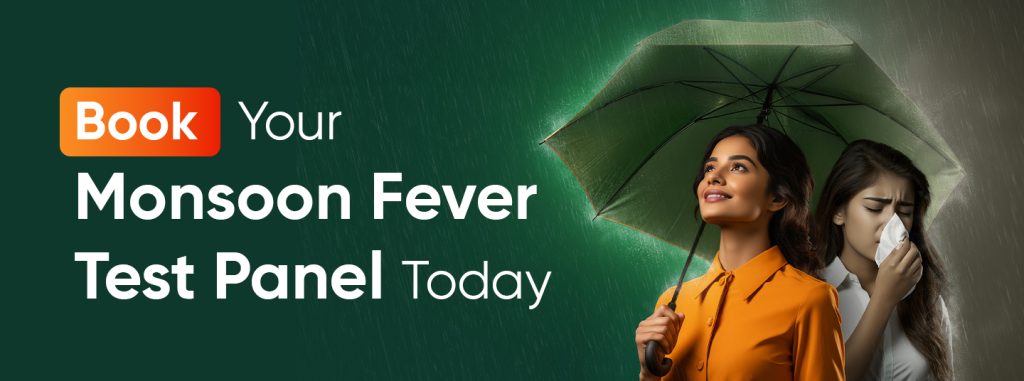Monsoon Alert: Fever? Get Tested at Yoda
The rainy season, really appreciated for having some relief from the heat, also increases health hazards – particularly fevers due to different infections. The increase in humidity, standing water, and changing weather this time of year provides perfect breeding conditions for illness-inducing viruses, bacteria, and parasites. The result? An increase in rainy season diseases, with fevers at the beginning.
Here are the ins and outs of the types of monsoon fevers, what is responsible for it, symptoms and precautions – beginning with timely testing at Yoda Diagnostics lab in Hyderabad!
Why Do Fevers Spike During the Monsoons?
A high humidity, contaminated water and bad sanitary conditions, the perfect stage for monsoon disease dissemination. Bacteria and viruses multiply in still water, and the air is full of them as well. Your immune system is having to rev up during that time, and even a minor exposure to germs can result in a fever. “Monsoon fever” is the term used for fevers that are frequently brought on in this season by mosquito-borne infections, contaminated water or food, and airborne viruses.
4 Major causes of monsoon fevers
1. Mosquito-Borne Diseases
Water, if left stagnating becomes a breeding ground for mosquitoes which are vectors for monsoon ailments. These diseases are very contagious and can result in serious complications if not treated quickly.
- Malaria
Parts of the Plasmodium parasite spread by infected Anopheles mosquitoes, malaria can rapidly spiral out of control if it is not nipped in the bud early. Early diagnosis through Malaria Antigen Test is crucial to avoid complications like seizures, renal failure, or even cerebral malaria.
- Dengue
Dengue – Dengue is also transmitted by Aedes mosquitoes and affects your blood platelet count. Without early diagnosis, it can be a life-threatening condition. The Dengue IgG ELISA Test can also be relied on with regard to the identification of antibodies and to provide prompt care.
- Chikungunya
Carried by Aedes albopictus mosquitoes, chikungunya causes intense fever, joint pain and fatigue. Joint pain may last several months in some patients.” It is frequently spread through stagnant rainwater around homes.
2.Airborne Diseases
The moist air in the monsoon arrests bacterial and viral multiplication, leading to further infections through sneeze, coughing and close contact.
- Influenza
The virus causing the seasonal flu attacks the respiratory system. Left untreated, it can progress to pneumonia and worsen chronic conditions like asthma or heart disease.
- Cold and Viral Fever
These sudden weather drops, wet clothes and low-immunity tend to hit the kids with colds, sore throat and mild fever. Though they are often mild, the illnesses can spread quickly, particularly among young children and older adults.
3. Waterborne Diseases
Then, there is the contamination of water through flooding and waterlogging; leading to more risk of being infected by bacteria and viruses.
- Cholera
This condition is caused by Vibrio cholerae, and it results in acute diarrhea and severe dehydration. In its most extreme form it can lead to deadly dehydration and electrolyte imbalances.
- Typhoid
It is spread by dirty food and water, induced by Salmonella typhi. These symptoms are fever lasting for several weeks, abdominal pain and fatigue.
- Jaundice
Frequently triggered by hepatitis or weak liver, jaundice during monsoon can be the result of drinking contaminated water or consumption of infected food, making the skin and eyes turn yellow plus are accompanied by itchy skin.
4. Food-Borne Infections
Food cooked and stored under unhygienic conditions, particularly those made by street vendors, turns into a prime carrier of diseases such as gastroenteritis and stomach flu. These frequently begin with fever, nausea and vomiting.
Caution Signs
Remain vigilant if you have, or a person you’re caring for has:
- High temperature
- Headache or dizziness
- Muscle cramps or joint pain
- Chills and sweating
- Skin rashes
- Vomiting or diarrhea
- Dehydration
- Sensitivity to light
- Fatigue and poor appetite
- Difficulty in breathing
- Fits (in serious infections)
Prevention of Monsoon Diseases: Keep Ahead of the Fever

- Hydration is key. Stay hydrated — herbal teas, water with lemon, and soups help.
- Increase your immunity by eating foods that are very rich in vitamin C like lemons, oranges, guavas, amla.
- Make it a habit to bath twice a day as well as wash yourself with antiseptic soaps regularly and keep yourself dry.
- Prevent mosquito bites by using repellents, mosquito nets and eliminating any standing water.
- Eat safely. Wash fruits and vegetables, drink boiled water and resist street food.
- Keep children away from those who are infected and make them wash their hands regularly.
Yoda Diagnostics for Testing
Early detection is the key to curtail the spread and impact of monsoon ailments. At US-based, NABL-certified Yoda Diagnostics the best laboratory in Hyderabad, we rule out the most prevalent fever-causing infections, all at once, using cutting-edge multiplex RT-PCR. Our Monsoon Fever Panel consists of:
- Dengue
- Chikungunya
- Malaria
- Typhoid
- Leptospirosis
- West Nile
- Rickettsia
- Zika Virus
- IL-6 Inflammatory Marker
- CBC (Complete Blood Count)
- Urine Examination
This wholistic method means quick, precise results and focused treatment for rapid pain relief.
Don’t wait it out! Fever is something that needs checking
Don’t dismiss a fever if you live in a rainy season. What may begin as a mild symptom could be a sign of a more severe rainy season disease. Routine fever monitoring aids in identifying early temperature spikes and any underlying infections before they become an issue. Look for a test, next, from Yoda Diagnostics lab in Hyderabad – Your health is worth more than a guess. Get your test done now and stay safe, protect your family from monsoon diseases.






















